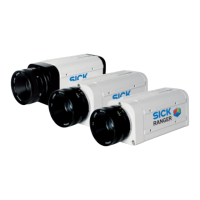
Do you have a question about the SICK Ranger E and is the answer not in the manual?
| Type | 3D camera |
|---|---|
| Power Supply | 24 V DC |
| Light source | Laser |
| Field of view | Varies by model |
| Measurement Range | Varies by model |
| Z-range | Varies by model |
| Accuracy | Varies by model |
| Interface | GigE |
| Operating temperature | 0°C to 45°C |
Explains how the Ranger measures objects using cross-sections and profiles.
Discusses critical factors for mounting and illumination for robust vision systems.
Details the process of configuring the Ranger for proper measurements and quality.
Outlines the process of writing applications to analyze and use Ranger data using APIs.
Explains the two external signal methods for triggering Ranger measurements: Enable and Pulse.
Details range measurement using triangulation with line-projecting lasers.
Discusses measuring light reflection for gloss, surface structure, and color properties.
Explains separating light sources for simultaneous measurements on different sensor parts.
Covers setup guidelines for color data acquisition, including geometry and illumination.
Lists typical light sources and their spectral properties for imaging applications.
Explains the two modes (Image, Measurement) and components for Ranger setup.
Defines the ROI, specifying columns and rows to optimize measurement rate and focus.
Details common triggering situations for various application types (continuous, discrete, etc.).
Explains using the Enable input for triggering profile capture, synchronizing with switches.
Describes pulse triggering via encoder for precise scan measurements based on movement.
Discusses cycle time and exposure time settings affecting profile rate and sensor exposure.
Details methods for locating laser lines in columns for range measurement.
Provides basic information on how measurement algorithms work, including laser impact position.
Explains measuring red, green, blue light and adjusting channels for quality color images.
Covers translating sensor coordinates to real-world coordinates using calibration.
Configures laser trigger output (Out2) for activation/deactivation and laser life.
Sets up communication parameters like redundancy and package size for Ethernet.
Configures the Ranger as a 2D camera for evaluation, including ROI settings.
Sets up parameters for 3D measurements, including triggering and cycle time.
Configures laser trigger output (Out2) for activation/deactivation and laser life.
Sets up communication parameters like redundancy and package size for Ethernet.
Configures the Ranger as a 2D camera for evaluation, including ROI settings.
Sets up parameters for measurements, including triggering, cycle time, and components.
Details the various built-in measurement methods (components) for Ranger E.
Steps to set up an application by connecting Camera and FrameGrabber objects.
Explains how applications retrieve data via IconBuffers, scans, and profiles.
Details methods for changing camera configuration via parameter files or single values.
Describes how to handle asynchronous errors reported by the API using an ErrorHandler.
Discusses using iCon Filter classes for calibration, rectification, and color processing.
Details the M12 Smart Vision Sensor, its architecture, and resolution.
Describes the M12 and RJ45 connectors, pinouts, and LED functions.
Provides detailed specifications for Ranger E and D models in tables.
Shows mechanical dimensions and mounting thread details for Ranger E and D.
Explains laser classification standards (IEC, CDRH) and categories.
Details laser classification based on power and emission duration.
Recommended settings for receive buffers to manage data flow and prevent packet loss.
Recommends Jumbo Frames for performance improvement and lower CPU usage.
Specifies IP address and Net mask for recommended network configuration.
Function to update the list of available devices in the configuration utility.
Dialog for changing the IP address of a selected device.
Allows uploading new Camera Application and Camera FPGA firmware.